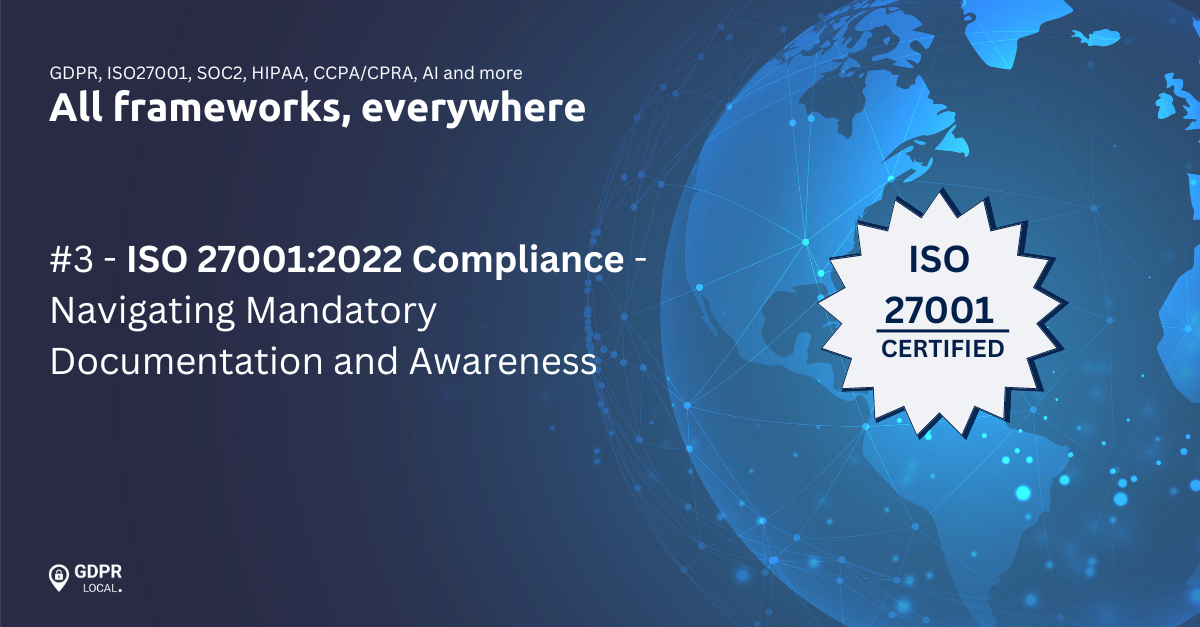
ISO 27001:2022 Compliance – Navigating Mandatory Documentation and Awareness
Adhering to recognized standards is vital for safeguarding sensitive data and ensuring organisational resilience. Among these standards, ISO 27001:2022 stands out for its comprehensive framework for Information Security Management Systems (ISMS). Central to achieving ISO 27001 compliance are mandatory documentation and awareness, key components that lay the groundwork for effective security measures.
Let’s delve into these concepts and their implications within the context of ISO 27001:2022.
Understanding Mandatory Documentation
Mandatory documentation under ISO 27001:2022 encompasses a set of essential policies, procedures, and records required for establishing, implementing, maintaining, and continually improving an organisation’s ISMS. These documents serve as the blueprint for safeguarding information assets and mitigating security risks. While the standard provides flexibility in documentation, certain documents are deemed indispensable for compliance.
Here we can describe seven essential documents for ISO 27001:2022 Compliance:
ISMS Scope Document
Defining the scope of the ISMS is crucial for delineating the boundaries within which information security measures apply. The ISMS Scope Document outlines the organisational context, boundaries, and applicability of the ISMS.
Information Security Policy
At the core of ISO 27001 compliance lies the Information Security Policy, articulating the organisation’s commitment to protecting information assets. It sets out the overarching principles, objectives, and responsibilities for information security management.
Risk Assessment and Treatment Methodology
ISO 27001 emphasises a risk-based approach to information security. Organisations must document their methodologies for identifying, assessing, and treating information security risks effectively.
Statement of Applicability (SoA)
The SoA identifies the security controls selected for implementation and their justification based on risk assessment outcomes. It provides transparency regarding the controls adopted to mitigate identified risks.
Risk Treatment Plan
Following the risk assessment, organisations must develop a Risk Treatment Plan detailing the measures to be implemented to address identified risks. This plan outlines specific actions, responsibilities, and timelines for risk mitigation.
List of Security Objectives
Documenting information security objectives helps align organisational goals with security priorities. These objectives should be specific, measurable, achievable, relevant, and time-bound (SMART), guiding the implementation of security measures.
Risk Assessment & Treatment Report
The Risk Assessment & Treatment Report provides a comprehensive overview of the organisation’s risk landscape, including identified risks, their assessment results, and proposed treatment measures. This report serves as a reference for ongoing risk management activities.
Significance of Awareness
Mandatory documentation alone is insufficient without robust awareness among stakeholders regarding their roles, responsibilities, and the significance of information security. Awareness initiatives, including training programs, communication campaigns, and regular updates, are essential for fostering a culture of security consciousness throughout the organisation.

The latest revision of ISO 27001:2022 brings positive changes regarding mandatory documentation requirements. Compared to the previous version, ISO 27001:2013, the 2022 revision requires fewer mandatory documents, streamlining the compliance process. Additionally, the inclusion of new security controls does not necessitate the creation of new documents; instead, organisations can integrate these controls into existing documentation frameworks.
In summary, mandatory documentation and awareness play pivotal roles in achieving ISO 27001:2022 compliance and enhancing information security posture. By meticulously documenting essential policies, procedures, and records and fostering awareness among stakeholders, organisations can strengthen their defences, mitigate risks, and demonstrate their commitment to information security. Embracing these principles empowers organisations to navigate the complexities of the digital landscape while safeguarding their valuable assets.